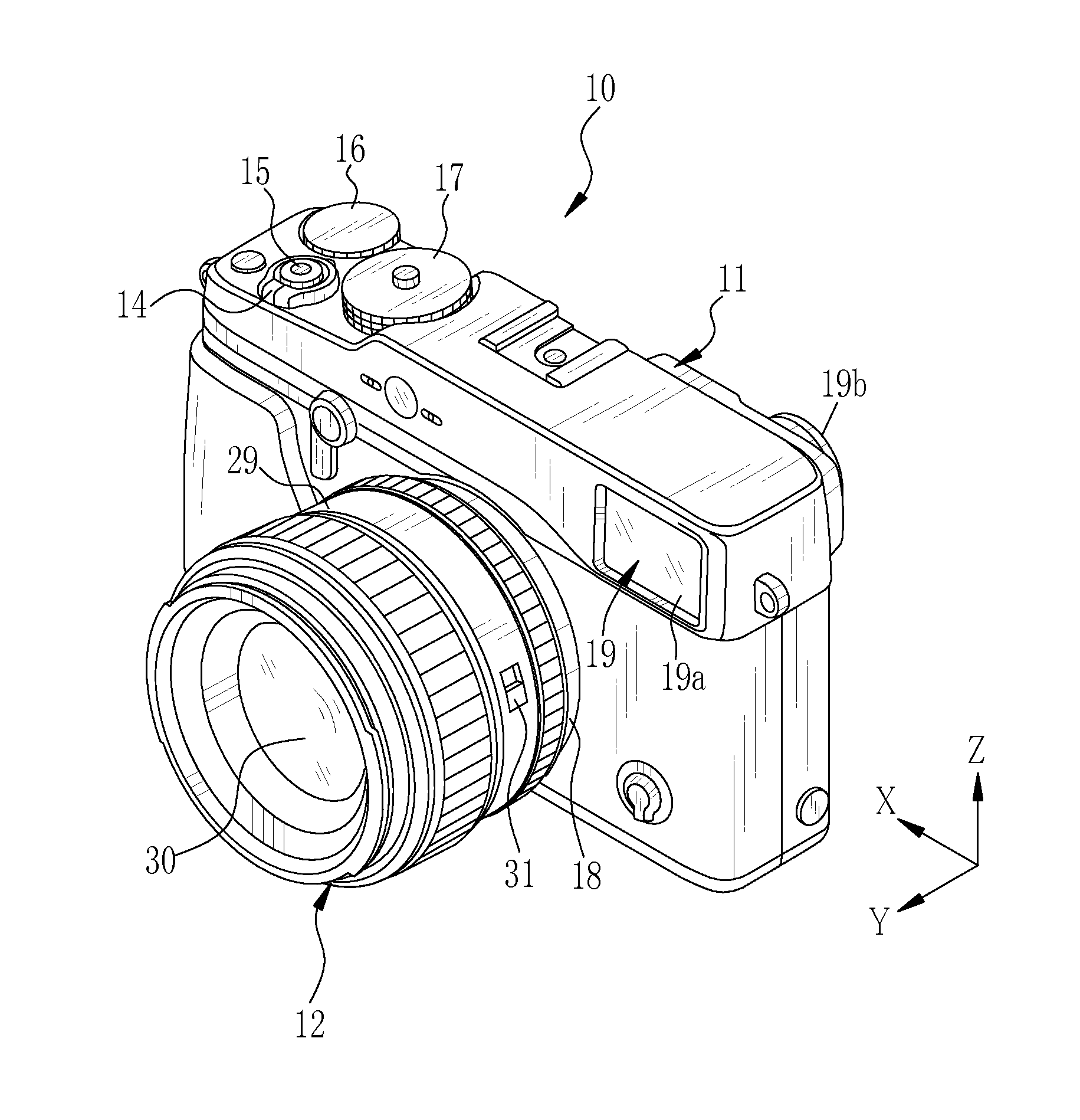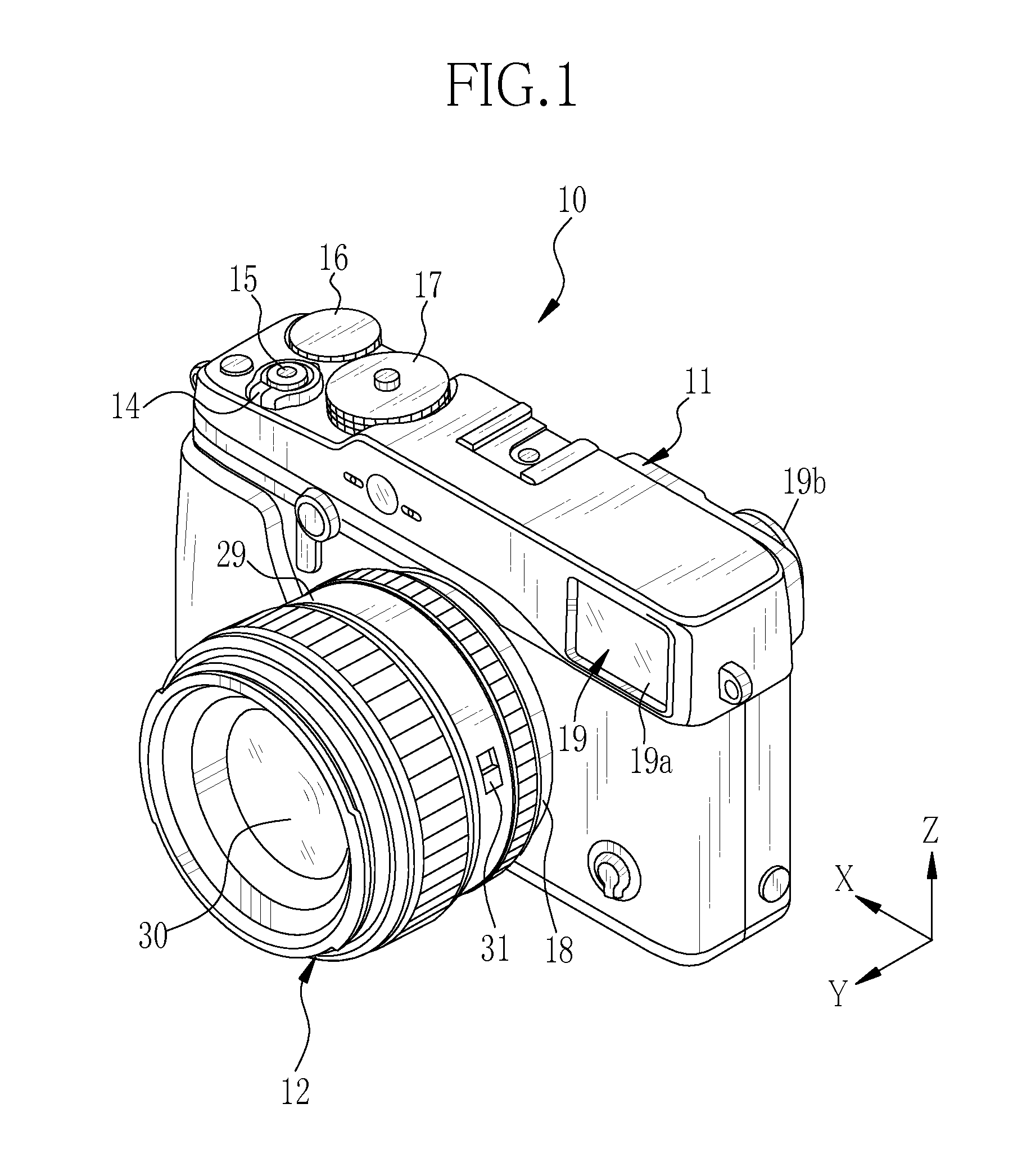Interchangeable lens digital camera
a digital camera and interchangeable lens technology, applied in the field of interchangeable lens digital cameras, can solve the problems of cmos sensor, cmos sensor, more affected by noise, inferior image quality, etc., and achieve the effect of reducing noise and reducing distortion
- Summary
- Abstract
- Description
- Claims
- Application Information
AI Technical Summary
Benefits of technology
Problems solved by technology
Method used
Image
Examples
first embodiment
[0062]In FIGS. 1 and 2, a lens interchangeable digital camera (hereinafter referred to as a camera) embodying the present invention is provided with a camera body 11, an interchangeable lens 12 that is detachably attachable to the camera body 11, and communication units that are electrically connected by attaching the interchangeable lens 12 to the camera body 11, enabling communication between the camera body 11 and the interchangeable lens 12. The camera 10 is a mirrorless single-lens reflex digital camera capable of using an appropriate interchangeable lens 12 for the purpose or intention of the photography. The camera 10 acquires an image of a subject through a CMOS sensor 21 that is integrated in the camera body 11. The camera 10 also has an optical shake compensation device 13 (refer to FIG. 4) which is integrated in the interchangeable lens 12 and makes a compensation for a camera shake so as to stabilize the optical image. The optical shake compensation device 13 may be call...
second embodiment
[0115]The second embodiment is configured to execute the second process even while the shake compensation device 13 is active under certain conditions that will lower the correcting effect on a rolling shutter distortion by the shake compensation device 13. As shown in FIG. 14, after the start of the shake detection (S12), the lens controller 36 starts determinations about a shake compensation limit and the panning (S32). Then, the determination result on the shake compensation limit and the determination result on the panning are transmitted to the body controller 67 through the serial communication unit 90, for example, along with the mode information on the shake compensation device 13 (S33).
[0116]For the determination on the shake compensation limit, the amount of a shake detected by the shake detection sensor 40 is compared with the shake compensation limit of the shake compensation device 13, to determine whether the shake amount exceeds the shake compensation limit or not. Th...
third embodiment
[0128]The third embodiment is configured to switch over between the first and second processes depending upon the operating conditions of the electronic zooming. As shown in FIG. 16, the electronic zooming is performed by the image data processor 72, cropping an image part from a live view image 120 within a zooming zone 121, which is determined according to a zoom magnification designated by the zooming operation, and enlarging the cropped image part to be displayed as a live view image 120a on the image display unit 24. As the image part within the zooming zone 121 is enlarged for the electronic zooming, also a rolling shutter distortion would be enlarged. Even while the rolling shutter distortion before the enlargement is in such a degree that does not need a correction, the enlarged distortion may have to be corrected. Therefore, during the electronic zooming, there may be cases requiring the second process.
[0129]According to the third embodiment, as shown in FIG. 17, the body c...
PUM
 Login to View More
Login to View More Abstract
Description
Claims
Application Information
 Login to View More
Login to View More - R&D
- Intellectual Property
- Life Sciences
- Materials
- Tech Scout
- Unparalleled Data Quality
- Higher Quality Content
- 60% Fewer Hallucinations
Browse by: Latest US Patents, China's latest patents, Technical Efficacy Thesaurus, Application Domain, Technology Topic, Popular Technical Reports.
© 2025 PatSnap. All rights reserved.Legal|Privacy policy|Modern Slavery Act Transparency Statement|Sitemap|About US| Contact US: help@patsnap.com



